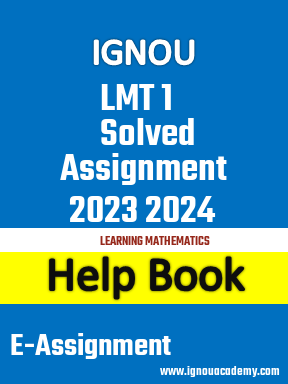My Cart

|
|
IGNOU LMT 1 2023 2024 Solution
IGNOU LMT 1 2023 2024 Solution|
|
| Title Name | IGNOU LMT 1 LEARNING MATHEMATICS Solved Assignment 2023 2024 |
|---|---|
| Type | Soft Copy (E-Assignment) .pdf |
| University | IGNOU |
| Degree | CERTIFICATE PROGRAMMES |
| Course Code | CTPM |
| Course Name | Certificate Programme in Teaching of Primary School Mathematics |
| Subject Code | LMT 1 |
| Subject Name | LEARNING MATHEMATICS |
| Year | 2023 2024 |
| Session | - |
| Language | English Medium |
| Assignment Code | LMT-01/Assignmentt-1//2023-24 |
| Product Description | Assignment of CTPM (Certificate Programme in Teaching of Primary School Mathematics) 2023-24. Latest LMT 01 2023-24 Solved Assignment Solutions |
| Last Date of IGNOU Assignment Submission | Last Date of Submission of IGNOU LMT-01 (CTPM) 2023-24 Assignment is for January 2023 Session: 30th September, 2023 (for December 2023 Term End Exam). Semester Wise January 2023 Session: 30th March, 2024 (for June 2024 Term End Exam). July 2023 Session: 30th September, 2023 (for December 2023 Term End Exam). |
| Assignment Code | LMT 1/2023 2024 |
|
|
Questions Included in this Help Book
Ques 1.
In what way does playing with tangrams help in developing spatial understanding? Explain with an example of children from Class III playing with tangrams.
Ques 2.
Write the numbers 0.00099, 0.03, 0.001, 0.6, 14, 1.005, 7 in descending order. What is the algorithm you used for doing this?
Ques 3.
Use the principle of Mathematical induction to prove 2 > 2 n for all n > .1
Ques 4.
What are the four stages of the scaffolding process? Illustrate these stages in the context of development of a number sense in young children.
Ques 5.
What is meant by
i) Rotation symmetry
ii) Glide symmetry
Ques 6.
Give three main difference between a map and a picture of a place. Give one situation with justification, in which a picture is a better representation of the situation than a map.
Ques 7.
Explain what a schema is. Further, explain the processes involved in elaborating a schema, through an example pertaining to a child of Class IV learning the concept of ‘angle’.
Ques 8.
Give an example of an axiom. What is the difference between an axiom and a theorem?
Ques 9.
Give a series of three activities, requiring different ability levels, to generate mathematical thinking in 30 children of Class IV. Explain why the activities are in a series.
Ques 10.
Manju claims, “By the time children reach class IX, most prefer science to mathematics.” What data is needed to test Manju’s statement? How would you gather it, record it, and analyse it to draw conclusions?
Ques 11.
Give an activity, with justification, to help develop the understanding of ‘variable’ for a Class VI child. This activity must have at least four qualities to be found in a good activity. Your answer must clearly specify how the activity has these qualities.
Ques 12.
What are three key aspects that define a model of learning? Explain these using the programming model. Why is this model considered inappropriate for teaching and learning?
Ques 13.
What is ‘mode’ of a set of data? Give an example, with justification, of data gathered in a real-life situation with more than one mode.
Ques 14.
Which of the following statements are true? Give reasons for yours answers. Marks are only for appropriate reasons.
a) Errors made while learning are a reflection of lack of practice and concentration on
the part of the learners.
b) There are about one-third learners in any class who are not capable of learning mathematics.
c) A good classroom must have pin-drop silence.
d) Knowledge is best acquired by memorisation.
e) A circle has more lines of symmetry than a square.
Ques 15.
What is divisibility rule for 11 in the decimal system? Explain this with two distinct examples. Further, what is the logic behind the rule?
Ques 16.
Write 30 in base 2 and base 5.
Ques 17.
Sanjit claims that if you toss a coin continuously, you can’t get 5 trails in a row, but you can only get at most 2 tails in a row. How would you help her understand that this not correct?
Ques 18.
Explain the difference in the processes of abstraction and generalisation. Give two detailed examples, one related to gender issues and one related to ‘data handling’, as a part of your explanation.
Ques 19.
Give your schema of ‘symmetry’. Also talk to a teenager near you and obtain her schema of ‘symmetry’. Are these the same? Give reasons for your answers.
Ques 20.
In the following sum, the letters represent distinct digits from 0 to 9. Find them, giving reasons behind each step you perform.
Further, is your solution unique? Why or why not?
Ques 21.
Explain how a game can have a learning objective, using an example pertaining to estimation of sum of decimal fractions.
Ques 22.
If you are a constructivist-oriented teacher, give three distinct ways in which you would assess the understanding of addition of numbers of 15 Class II children.
Ques 23.
Explain how a game can have a learning objective, using an example pertaining to estimation of sum of decimal fractions.
Ques 24.
If you are a constructivist-oriented teacher, give three distinct ways in which you would assess the understanding of addition of numbers of 15 Class II children.
|
|
Related Assignments
IGNOU Doubts & Queries
Click to Contact Us
Call - 9199852182 Call - 9852900088 myabhasolutions@gmail.com WhatsApp - 9852900088